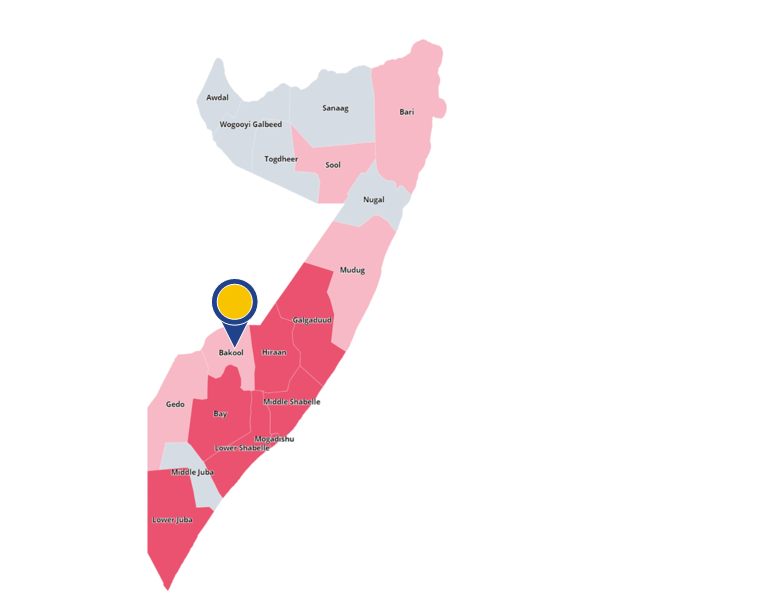COMMON ANALYSIS
Last update: August 2023
The situation in Bakool should be seen in light of the situation in the neighbouring region of Bay.
Main COI references: [Security 2023, 2.2.1., pp. 82-90; COI Update 2023, 1.3.4., pp. 16-19]

General information
Bakool region is located in the south-west of Somalia, bordering Ethiopia. The region consists of five districts. The region’s capital is Xudur.
The region is mainly inhabited by Rahanweyn groups (predominantly Mirifle). The region’s area bordering Ethiopia is mainly inhabited by the Jajele (Hawiye) and the Aulihan (Ogaden/Darood) clans.
In 2021, UNOCHA estimated the population of Bakool region at 459 747 inhabitants.
Background and actors involved in armed confrontations
The region is characterised by the presence of a variety of armed actors. The main source of conflict in Bakool is the on-going armed confrontation between Al-Shabaab and anti-Al-Shabaab forces including State and federal state forces, the Macawiisley clan-based militia and the Ali Qaran militia. The heavy presence of Ethiopian security forces along the Somali-Ethiopia border acted as deterrent to Al-Shabaab’s activity in the area but did not reduce its motivation to launch attacks. The group was involved in 148 out of the 159 security incidents reported in Bakool between 1 July 2021 and 30 November 2022.
Control over most of the region was either unclear or contested between Al-Shabaab and ATMIS/AMISOM and the federal state forces. State and federal state forces maintained control of the capital Xudur and of the key towns Ceel Barde, Yeed, and Waajid. Federal state forces and ATMIS/AMISOM had the control of the area bordering Ethiopia. However, border towns, Yeed and Ato, as well as the Washaaqo village, were attacked by Al-Shabaab in late July 2022 and came under the group’s control for a very brief period of time. FGS forces lacked the capability to maintain control over captured territory, while Al-Shabaab kept the control over major supply routes. By November 2022, Al-Shabaab retained control of the rural areas of the region while it also seized control of the towns of Tayeeglow, Garasweyne and of the, previously contested, Radbhure.
Nature of violence and examples of incidents
The incidents related to Al-Shabaab involved either Ethiopian forces, Somali military forces or ATMIS/AMISOM and were mostly battles or explosions/remote violence.
A battle occurred between Ethiopian Liyu police and Al-Shabaab after an attack by the latter on Ethiopian military camps in the towns of Ato and Yeed along the Somali-Ethiopian border on 20 July 2022. After heavy fighting, Al-Shabaab claimed to have seized these areas, but finally withdrew on the same day. Shortly after, the group launched a mortar attack against a large Liyu police garrison at the village Washaaqo, killing dozens of Liyu police in the two attacks.
Illustrative security incidents include, for example, the launch of an air strike by Ethiopian forces targeting the Al-Shabaab-held town Garasweyne (in the outskirts of Xudur) on 30 July 2022 which caused at least one civilian casualty.
Inter-clan clashes also occurred between pastoral communities over the use of farmland. In May 2022, clashes occurred between Mirifle sub-clans.
Incidents: data
ACLED recorded 159 security incidents (an average of 2.2 security incidents per week) in Bakool region between 1 July 2021 and 30 November 2022. Out of those incidents, 120 were coded as ‘battles’, 32 as ‘explosions/remote violence’ and 7 as ‘violence against civilians’. In the period from 1 December 2022 to 14 April 2023, 31 security incidents were recorded in Bakool representing an average of 1.6 security incidents per week. Out of those incidents, 20 were coded as ‘battles’.
Geographical scope
Security incidents occurred in all 5 districts of Bakool with the largest overall number being recorded in Xudur (76 incidents) followed by Waajid (47 incidents).
Fatalities among civilians and non-civilians
In the 17 months between July 2021 and November 2022, ACLED recorded a total of 452 fatalities in the region. In the 4.5 months between December 2022 and mid-April 2023, ACLED recorded a total of 10 fatalities in the region. Compared to the figures for the population in the region as from 2021, this represents approximately 100 fatalities per 100 000 inhabitants for the whole reference period.
Displacement
Between July 2021 and November 2022, 56 735 individuals were newly displaced from Bakool, according to PRMN. Of these, 72 % were displaced within the region, while the remaining 16 095 individuals were displaced to other regions, especially to Benadir, Gedo and Bay. Almost 70 % of all recorded displacements from Bakool to other regions or other areas within Bakool were a result of the attacks launched in July 2022 by Al-Shabaab in Yeed, Ato and Waashaqo.
Between December 2022 and March 2023, 294 individuals were newly displaced from Bakool, according to PRMN.
Further impact on civilians
Food insecurity imposed by Al-Shabaab blockades of supply routes continued to affect the region, especially the capital Xudur and the Waajid district. Al-Shabaab fighters attacked vehicles transporting food supplies including donkey carts. Two humanitarian access incidents were documented by UNOCHA during the reference period.
Looking at the indicators, it can be concluded that indiscriminate violence is taking place in the region of Bakool, however not at a high level. Accordingly, a higher level of individual elements is required in order to show substantial grounds for believing that a civilian, returned to the territory, would face a real risk of serious harm within the meaning of Article 15(c) QD.
